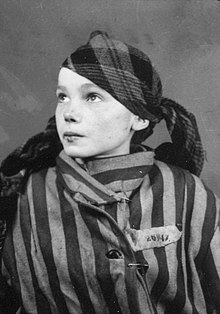Czesława Kwoka
This article does not have any sources. (September 2023) |
Czesława Kwoka (15 August 1928 – 12 March 1943) was a Polish-born Roman Catholic girl, who was one of the German displacement and pacification action victims, which were carried out in the Zamość region in German-occupied Poland, as part of the
Generalplan Ost. She was one of the children of the Zamość region, sent by the Germans to concentration camps.
Czesława Kwoka | |
|---|---|
 Photograph of Czesława Kwoka, photographed in Auschwitz-Birkenau in late 1942 or early 1943 | |
| Born | 15 August 1928 |
| Died | 12 March 1943 (aged 14) Auschwitz-Birkenau concentration camp, German-occupied Poland (modern-day Poland) |
| Cause of death | Phenol injection to the heart |
| Nationality | Polish |
| Occupation | Student |
| Known for | One of many people during the war to have their "identity photographs" taken at Auschwitz-Birkenau. |
| Parents |
|
Biography
changeLife and family
changeCzesława Kwoka was born into a Polish-born Roman Catholic family. Before the war started, she lived in the town of Wólka Złojecka, in house number 12 (currently the village is located in the Lublin Voivodeship). Czesława went to elementary school in Złojec, approximately 4 kilometres from her house (it is currently named The Elementary School of the Children of the Zamość region).
Her mother Katarzyna Kwoka, who was born on 1 April 1896, worked as a farmer. Her father's name was Paweł Kwoka. Documents from the Auschwitz-Birkenau concentration camp state that his last place of residence was in Wólka Złojecka. According to Eugeniusz Piróg's account, Katarzyna was a widow and raised her children alone.
Detainment in the Zamość transit camp
changeAs part of the implementation of Generalplan Ost in 1942, the displacement of residents from the regions next to Zamość began. They were divided into districts. Wólka Złojecka and seven nearby towns were assigned to the largest town, Złojec in the Nielisz commune. Beginning in early December 1942, people residing in towns belonging to the Nielisz commune, were evacuated. On 2 December, people residing in the town of Wólka Złojecka (where Czesława and her mother Katarzyna lived in) had been put on evacuation. Obviously Czesława and her mother Katarzyna were evacuated. They and a few other residents of Wólka Złojecka were sent to the newly-built Zamość transit camp.
Detainment in the Auschwitz-Birkenau concentration and extermination camp
changeOn the evening hours of 12 December 1942, the first transport of 318 women and girls left the Zamość transit camp to go to Auschwitz-Birkenau. They arrived in their destination the next day. Czesława and her mother Katarzyna were in that transport. In total, there were three transports of inmates who arrived in Auschwitz-Birkenau, leaving from the Zamość transit camp.
Czesława and her mother Katarzyna were one of many people to have their "identity photographs" photographed in Auschwitz-Birkenau. Those "identity photographs" would later be stored in the so-called "Death Books".
Katarzyna Kwoka died in Auschwitz-Birkenau from undetermined causes on 18 February 1943. Less than one month later, Katarzyna's daughter Czesława Kwoka also died on 12 March 1943 in Auschwitz-Birkenau, also from undetermined causes. Whilst after the war ended, it was later revealed that Czesława died after a phenol injection was injected in her heart, Katarzyna's cause of death has yet to be revealed, and still remains undetermined and disputed.
It is unknown exactly who took Czesława's photographs in the Auschwitz-Birkenau concentration and extermination camp.
Decades after the war ended, Wilhelm Brasse, a Auschwitz-Birkenau survivor, claimed to have taken those photographs. Brasse was known to be a professional photographer before the war began. In Brasse's account before he (supposedly) took her photographs, the girl [Czesława] was (supposedly) whipped by one of the supervisors for "not being obedient". In 2005, a documentary film Portrecista was released, directed by Ireneusz Dobrowolski, which talks about Brasse and his (supposed) work as a photographer taking "identity photographs" of inmates in the Auschwitz-Birkenau concentration and extermination camp (including the photographs of Czesława Kwoka).
Czesława Kwoka's photographs from the Auschwitz-Birkenau camp, shows that her striped inmate uniform has a red triangle on it, which, according to the rules for the identification of inmates in the Germans concentration camps was worn by anyone defined as a political prisoner ("Schutzhäftlinge") in Auschwitz in order to "protect those inmates".